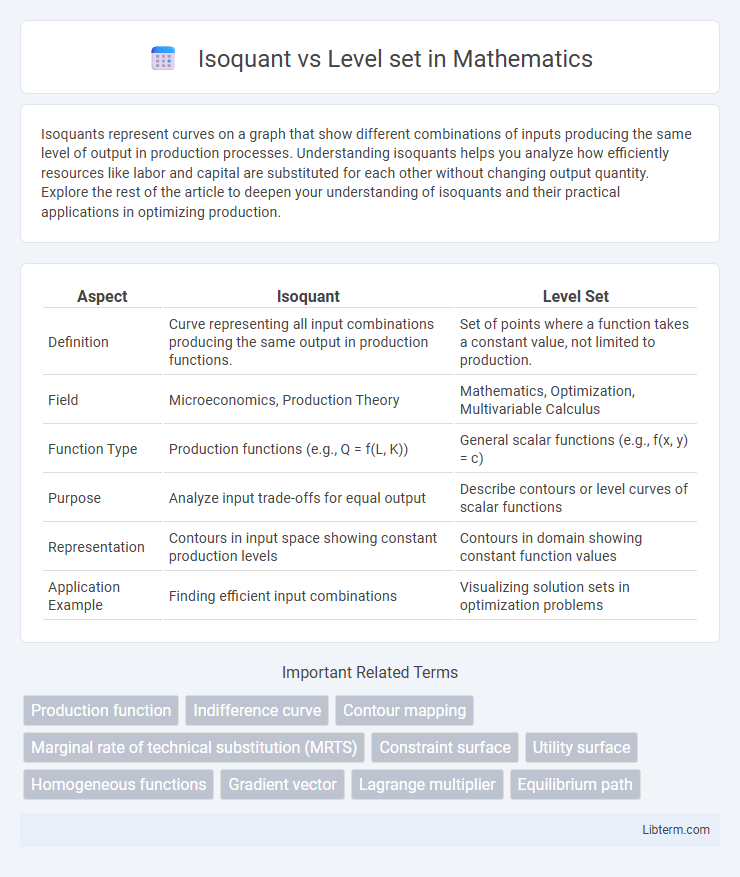Isoquants represent curves on a graph that show different combinations of inputs producing the same level of output in production processes. Understanding isoquants helps you analyze how efficiently resources like labor and capital are substituted for each other without changing output quantity. Explore the rest of the article to deepen your understanding of isoquants and their practical applications in optimizing production.
Table of Comparison
| Aspect | Isoquant | Level Set |
|---|---|---|
| Definition | Curve representing all input combinations producing the same output in production functions. | Set of points where a function takes a constant value, not limited to production. |
| Field | Microeconomics, Production Theory | Mathematics, Optimization, Multivariable Calculus |
| Function Type | Production functions (e.g., Q = f(L, K)) | General scalar functions (e.g., f(x, y) = c) |
| Purpose | Analyze input trade-offs for equal output | Describe contours or level curves of scalar functions |
| Representation | Contours in input space showing constant production levels | Contours in domain showing constant function values |
| Application Example | Finding efficient input combinations | Visualizing solution sets in optimization problems |
Introduction to Isoquants and Level Sets
Isoquants represent combinations of input factors producing the same output level in production theory, essential for understanding input substitution and efficiency. Level sets generalize this concept across various functions, defining points where a multivariate function attains constant values, critical in mathematical optimization and contour analysis. Both concepts visualize constant-output or constant-value conditions but differ in application scope, with isoquants specific to economics and level sets applicable across disciplines like physics and machine learning.
Defining Isoquants in Economics
Isoquants in economics represent curves that illustrate combinations of two inputs yielding the same level of output, serving as a crucial tool in production theory. Unlike level sets in mathematics, which define points where a function takes constant values, isoquants specifically map input quantities in production processes. Understanding isoquants allows firms to analyze input substitution effects and optimize resource allocation for efficient production.
Mathematical Concept of Level Sets
Level sets in mathematics represent collections of points where a function attains a constant value, often visualized as contour lines or surfaces in optimization and economic models. Unlike isoquants, which specifically illustrate combinations of inputs producing the same output in production theory, level sets generalize this concept to any scalar function, enabling analysis of gradients and critical points. This abstraction facilitates solving partial differential equations and optimization problems by examining the geometry and topology of the function's constant-value regions.
Core Differences Between Isoquants and Level Sets
Isoquants represent combinations of input factors producing the same output level in production theory, emphasizing input substitution effects, while level sets in mathematics denote points where a function maintains constant value, often applied to multidimensional scalar fields. Isoquants specifically analyze factor inputs like labor and capital in economics, showing trade-offs in production, whereas level sets generalize to any function, including cost, utility, or physical phenomena, without direct economic interpretation. The core difference lies in isoquants being economic tools for production optimization, contrasted with level sets as broader mathematical constructs describing constant-value contours.
Graphical Representation: Isoquants vs Level Sets
Isoquants represent combinations of input factors yielding a constant output level in production theory, typically depicted as smooth, convex curves on a graph with input quantities on the axes. Level sets illustrate points where a multivariate function takes the same constant value, often shown as contour lines on topographic maps or heatmaps in mathematical and engineering contexts. Both isoquants and level sets graphically convey equi-value conditions but differ in application, with isoquants specific to economics and level sets used broadly in multivariate analysis.
Applications of Isoquants in Production Theory
Isoquants represent combinations of input factors yielding the same level of output, crucial for optimizing resource allocation in production theory. They help firms determine the most efficient input mix to minimize costs while maintaining output levels, enabling cost minimization and profit maximization. Isoquants also facilitate the analysis of substitutability between inputs, guiding technological improvements and decision-making in production planning.
Level Sets in Mathematics and Optimization
Level sets in mathematics represent contours or surfaces where a function maintains a constant value, commonly used to analyze solutions of differential equations and optimize multivariable functions. In optimization, level sets help identify regions of interest by describing feasible sets or objective function values, aiding in visualizing gradients and constraints. Unlike isoquants in economics that depict input combinations for fixed output, level sets offer a broader application in multidimensional optimization and function analysis.
Interpretational Context: Economics vs Mathematics
Isoquants in economics represent combinations of inputs yielding the same level of output, emphasizing production efficiency and resource allocation. Level sets in mathematics generalize this concept as curves or surfaces where a multivariate function attains a constant value, focusing on function analysis and geometry. The interpretational context distinguishes isoquants as tools for economic decision-making, whereas level sets serve broader applications across mathematical fields.
Advantages and Limitations of Each Concept
Isoquants provide a clear visualization of combinations of inputs that yield the same output level, facilitating efficient resource allocation in production analysis. Their limitation lies in assuming smooth, continuous substitutability between inputs, which may not hold in real-world scenarios with discrete or fixed input proportions. Level sets, by representing equal-value contours of a mathematical function, offer broader applicability beyond economics but may lack intuitive interpretation in production contexts and can be computationally complex for high-dimensional input spaces.
Conclusion: Selecting the Appropriate Tool
Selecting the appropriate tool between isoquants and level sets depends on the specific application and analytical focus; isoquants are ideal for representing production functions and input combinations yielding equal output, while level sets effectively illustrate contours of multivariable functions in various fields. Isoquants emphasize economic input-output relationships, aiding in cost minimization and production efficiency analysis. Level sets offer greater versatility in visualizing complex functions beyond economics, making them suitable for broader mathematical and engineering problems.
Isoquant Infographic

 libterm.com
libterm.com